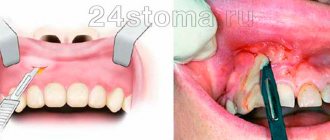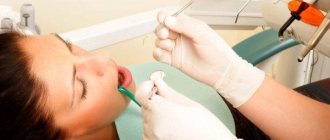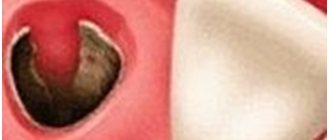Dental treatment can be therapeutic or surgical, and pain can occur after any type of intervention. If your wisdom tooth hurts after treatment, in most cases, this is a normal physiological reaction of the tissues to the procedure performed. Usually, painful sensations are quickly relieved with painkillers and go away on their own within a couple of days. But there are situations when pain after removal of the figure eight occurs due to complications or a violation of the technology of the therapeutic manipulation.
The dentist will definitely consult the patient about how the recovery process after the intervention should normally proceed, and if any symptoms appear, you should immediately consult a doctor. If all the doctor’s recommendations regarding the rehabilitation period are followed, but the painful sensations only increase, this is a direct indication to come for another appointment.
Types of deletion
Wisdom teeth (eights, third molars) are larger than other dental units in the row. They differ not only in size, but also in the complex anatomy of the root system. Eight has from 2 to 6 roots
, which are often closely intertwined with each other. Given the complex arrangement of wisdom teeth, when they are removed, a significant wound is created.
The risk of complications will directly depend on how difficult the figure eight extraction was. With simple extraction, when the tooth is intact, the roots are not intertwined, and there are no other pathologies (pulpitis, periodontitis, etc.), the risk of complications is minimal. In such a situation, the doctor uses forceps or an elevator to remove the tooth from the socket.
If the wisdom tooth is incorrectly positioned (horizontal eruption, severe curvature), intertwined roots, significant destruction of the coronal part, or the presence of inflammation, a more global surgical intervention may be required. An incision in the gum, cutting a tooth into pieces with a drill, removing root fragments through the jaw bone and other manipulations significantly increase the traumatic nature of the procedure. Aching pain, swelling after removal of the figure eight, increased temperature (up to 37.5℃), hematoma on the cheek - this is a normal reaction to the intervention, which lasts no more than 5-7 days.
Prevention methods
Tooth extraction is often required when the 3rd molar (molar) is out of position. However, surgery is also prescribed for caries, abscesses and cysts, and injuries. To prevent caries, you should pay enough attention to oral hygiene, undergo regular dental checkups and clean the enamel from plaque and tartar. Immediately after surgery, it is important to observe several conditions that will help avoid complications and headaches:
- use disinfectant solutions for the oral cavity - they clean the wound from pathogenic microflora;
- take only soft, liquid food in the first few days, so as not to further injure the socket;
- Do not remove a blood clot from the postoperative socket yourself, but if it falls out, consult a doctor.
At the Clinical Brain Institute, you can undergo all the necessary examinations, determine the exact cause of the headache and receive a competent treatment regimen. Our center employs only experienced specialists, general and specialized doctors, as well as modern, precision equipment. There are all conditions for quick and high-quality diagnosis, regular examinations, as well as outpatient and inpatient treatment of headaches.
Why complications arise
After extraction, a wound is left in the gum and bone in which a blood clot (fibrin) forms. It “seals” the wound, preventing infection, and becomes the basis for the formation of new tissue that fills the space formed after the removal of the 8. After uncomplicated removal, healing lasts about a week. On days 3-4, the blood clot is gradually replaced by granulation tissue, which gradually fills the entire socket. Already after a month, the granulation tissue is completely replaced by connective tissue, and after 3 months - by bone.
Removal of third molars can have negative consequences that appear almost immediately after the intervention. Among the most common complications:
- “dry socket” - when a blood clot does not form or dissolves too quickly;
- paresthesia - damage to the nerve endings around the removed unit;
- alveolitis - inflammation of the socket;
- bleeding;
- cyst - fibrous formation at the site of an extracted tooth;
- endogenous periostitis (flux).
In rare cases, stomatitis, osteomyelitis, jaw trauma, and perforation of the bottom of the maxillary sinus are observed. The occurrence of complications is usually associated with ignoring the dentist’s recommendations regarding oral hygiene during the healing period, decreased immunity, and violation of surgical technique.
Treating periodontitis correctly
Periodontitis is an inflammatory process in the gum surrounding the tooth. It can lead to weakening of the ligamentous apparatus of the tooth and its loss. We will lose a perfectly healthy tooth due to gum problems. Moreover, such inflammation is extremely painful and dangerous. The reason for its occurrence is due to changes in our diet. The food has become softer, there is no need to put stress on the teeth when chewing it - and this is the result. The teeth have weakened. Urgent assistance from a periodontist is needed, who will thoroughly clean the subgingival pockets of stone, plaque and infection, and place medications in the cavities affected by the infection. Usually this is quite enough to quickly improve the situation. To completely eliminate relapses of the disease, it is extremely important to regularly remove tartar and plaque from the surface of your teeth. Advanced cases also require taking antibacterial drugs.
Pain after wisdom tooth removal
Patients are always interested in the question, how many days does the jaw hurt after wisdom tooth removal? Pain after surgery is a standard tissue response to injury. Normally, the pain subsides within a few hours or within 3 days after extraction (in case of complicated removal). The pain a patient experiences after wisdom tooth removal indicates the success of the procedure.
- The first discomfort and pain appear 2-3 hours
after the intervention (when the anesthetic wears off). - The first 3-4 days
there is aching pain, redness and swelling of the soft tissues. If the extraction is successful and the hole is properly cared for, the pain will gradually disappear. - Over the next 2 weeks
, if there are no complications, the wound will heal completely, and minor pain may occasionally occur in the late afternoon. - After 3 weeks,
all discomfort should disappear.
If a wisdom tooth has been pulled out and it hurts for more than 5 days, the intensity of the pain increases, it becomes throbbing, debilitating, accompanied by fever, swelling - this indicates a complication and requires immediate medical intervention.
Causes of pericoronitis
The disease most often results from:
- epithelial injuries due to difficult long-term tooth eruption;
- impacted (formed, but not erupted outward) teeth;
- atypically located tooth roots;
- thickening of the gum mucosa;
- accumulation of soft plaque under the hood and, accordingly, infection of tissues;
- reduction in the size of the dental arch, lack of space for teething;
The catalyst for pericoronitis of wisdom teeth is often a source of infection in the oral cavity. Very often the disease is provoked by caries, stomatitis or periodontitis. Sometimes the disease occurs against the background of ignoring the rules of personal hygiene, prolonged stress, hypovitaminosis and other conditions accompanied by decreased immunity.
What could be causing the pain?
If the pain after removing the figure eight does not subside within 5-7 days, but rather intensifies, this may indicate the following complication:
- Alveolitis
is an inflammation of the socket associated with the absence of a blood clot, poor hygiene, infection of the wound, or the presence of a bone fragment in the socket (if the tooth was extracted in parts). - Severe damage to the blood vessels
of the surrounding tissues - in addition to pain, there is a hematoma, swelling of the gums and cheeks. - Allergy
to anesthetic, hemostatic sponge (if it was used during the procedure).
As inflammation develops, pain is accompanied by an unpleasant odor, purulent discharge from the socket, the formation of gray plaque, enlarged lymph nodes, increased temperature, and deterioration in general well-being. In this case, you need to see a doctor immediately.
Aching jaw
When the jaw hurts after wisdom tooth removal, it is usually due to the fact that the surgeon put pressure on it to gain access to the molar. Or during the procedure, blood vessels, nerve endings, and ligaments of adjacent dental units were injured. These symptoms are quite normal, if there is no difficulty opening the mouth, there is no pronounced swelling of the gums or soft tissues of the face.
It hurts to swallow
After extraction of the lower 8, you may experience a sore throat or pain when swallowing. This symptom appears against the background of severe damage to soft tissues, with severe swelling of the gums, cheeks, or due to trauma to the trigeminal nerve. If the trigeminal nerve was affected during the operation, there is not only pain, which can radiate to the temple, ear, neck, but numbness on the face, in the area of the removed unit, and increased salivation. Also, a sore throat may occur if there is inflammation or purulent process around the affected molar. This symptom can last up to 2 weeks. To avoid complications, you should visit a neurologist or dentist.
Throbbing pain
If your gums ache after wisdom tooth removal, but the discomfort is quickly relieved with an analgesic and disappears after 2-3 days, this is evidence of normal healing. On the contrary, throbbing pain in the jaw or gums indicates possible inflammation, damage to blood vessels and nerves. With neuritis (damage to the jaw nerves), it can radiate to the neck, throat, temple, ear, eye. The pain increases, prevents you from falling asleep, and interferes with normal life - in this case, you need to immediately consult a dentist, this is a sign of inflammation.
Galvanic syndrome
This is the case when physics interferes with physiology. Painful sensations are caused by microscopic current discharges, which have an extremely unpleasant effect on the vulnerable mucous membrane of the mouth. The syndrome occurs due to the fact that in your mouth there are fillings and other dental structures that contain many metals and alloys that are widely used in modern dentistry. An artificial tooth contains a lot of conductive materials and as a natural result: the current irritates the delicate mucous membrane, which leads to the development of inflammation, and this process can spread further to the throat. Eliminating this problem is quite simple, although it is associated with material and aesthetic losses. It is necessary to remove the current conductor - the dental structure. Experience shows that the pain disappears almost instantly, although the inflamed tissues will need time to recover. Well, there is a need to replace the removed structures. Usually, in this case, the doctor prescribes you a course of restorative immunotherapy to minimize all the negative effects of irritants. And problems with missing teeth will be solved by ceramic materials. They are beautiful, natural and have no problems with conductivity.
How to relieve pain and discomfort
- Do not touch the blood clot in the socket with your tongue, toothbrush, hands or foreign objects;
- make oral baths from herbal decoctions and antiseptic solutions;
- if the pain radiates to the ear or another part of the head, take a painkiller;
- exclude hot food and drinks.
If your gums hurt for several days after wisdom tooth removal or you have a headache, you don’t need to worry too much. Analgesics prescribed by your dentist will help you cope with these symptoms. If the discomfort does not go away after a week, painkillers do not help much - you need to go to the doctor. If the temperature is above 37.5℃, which does not decrease to normal, the development of an allergic reaction (to an analgesic, hemostatic sponge), or a sharp deterioration in health, you should consult a doctor immediately.
How to take care of your teeth to avoid problems
- We brush our teeth at least 2 times a day;
- We use dental floss and dental elixir;
- We visit the dentist at least 2 times a year, and also immediately as necessary;
- We regularly carry out the procedure for removing tartar;
- We choose toothpastes on the recommendation of your doctor, and not based on television advertising;
- We refuse enamel-damaging whitening pastes. If desired, a whitening procedure can be performed at a dental clinic.
Doctors constantly remind us of the need to be more attentive to our health. Dental health is an important component of the overall health of the body. The consequences of a careless attitude towards dental health can be extremely unpleasant.











